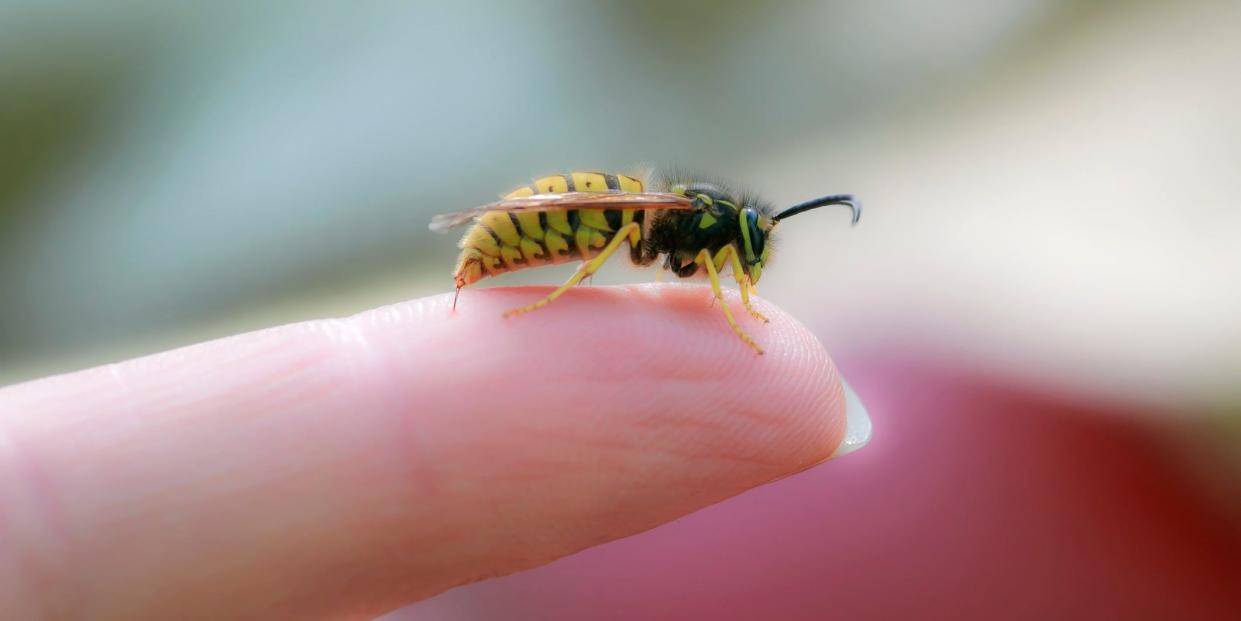The most effective treatments and home remedies for a wasp sting

Nataba/Getty Images
To treat a wasp sting, you'll need to reduce swelling and inflammation.
For example, you can apply ice or a cold compress to the sting site, as well as taking Advil or Tylenol for pain relief.
If you have an allergic reaction to a wasp sting, and experience any breathing or airway troubles, you should seek immediate medical attention.
This article was medically reviewed by Jason R. McKnight, MD, MS, a family medicine physician and clinical assistant professor at Texas A&M College of Medicine.
This story is part of Insider's complete guide to Bug Bites.
Stinging insects, like bees and wasps, can be a nuisance during the warmer months, when they are most active.
Wasps are especially aggressive and can sting you many more times than a bee would. Wasp stings are painful and irritating, and may even be dangerous if you have an allergic reaction.
Here's what you should know about wasp stings, how to treat them effectively, and what you can do to prevent them.
Wasps vs. bees
The main difference between wasps and bees is that bees are vegetarians and wasps are carnivores.
According to Keith Delaplane, PhD, Director of the Honey Bee Program at the University of Georgia, wasps feed off animal protein — which is why you might see them eyeing your hamburger at a summer barbecue.
Wasps are narrower than bees with pointed lower abdomens. Some types of bees, such as honey bees, will die after they sting, while wasps can sting more than once.
While both insects will defend their nest if threatened, wasps tend to be more aggressive and use their stinger as a weapon for hunting.
Symptoms
It can be hard to tell a wasp from a bee sting, Delaplane says, except for one notable marker.
If you're stung by a honey bee, it will leave its stinger in your skin, appearing as a little black dot in the sting. Wasps, on the other hand, will keep their stinger.
If a wasp stings you, you'll likely experience the following symptoms near the site:
Redness and warmth
Pain and swelling
Hives
Itchiness
The above symptoms are common and not a sign of an allergic reaction, Delaplane says.
Courtney Jackson Blair, MD, an allergist and immunologist in Virginia, says people experiencing an allergic reaction to a wasp sting will have symptoms that interfere with their ABCs: airway, breathing, and circulation. For example, these symptoms could include:
Hives or swelling that is well beyond the sting area
Trouble breathing
Tickling or tightness in the throat or chest
Lightheadedness or dizziness
Vomiting
Fainting
Insect sting allergies are rare, but can be fatal. In 2017, for example, allergic reactions to insect stings killed 89 Americans, according to the Centres for Disease Control and Prevention.
In order to develop an insect sting allergy, you need to be stung, Blair says — so you may not know you have an allergy until you experience symptoms.
Some people may only have mild or moderate allergic reactions that can be treated at home, but if you are experiencing multiple symptoms, it might be more severe.
If you think you are having a severe allergic reaction to an insect sting, Blair says you should call 911 or your local emergency medical services right away.
How to treat a wasp sting
In the vast majority of cases, you can treat a wasp sting at home without seeking further medical care.
To treat a local skin reaction to a wasp sting, follow these steps from Johns Hopkins Medicine:
1. Wash the affected site thoroughly with soap and water.
2. Apply ice to the sting area to decrease swelling and pain (leave it on for 10 minutes, then remove it for 10 minutes, over the course of 30 minutes to an hour).
3. Raise the body part where the sting is located to help reduce swelling.
4. To further treat swelling and itching, consider taking an over-the-counter antihistamine, like Claritin. You can also take Tylenol (acetaminophen) for pain relief.
5. If your symptoms worsen or begin affecting your ABCs, call 911.
Home remedies
There are also several home remedies you can use to treat wasp stings:
Mix non-seasoned meat tenderizer powder with a little bit of water. Then use a cotton ball to apply it to the sting area, and leave it on for 15 to 20 minutes. Meat tenderizer has a chemical called papain that can break down wasp venom to reduce pain and swelling.
A paste of baking soda and a little water can also break down or neutralize the venom. as with the meat tenderizer, apply it to the sting area and leave it on for 15 to 20 minutes.
A cool, wet tea bag can help fight inflammation and reduce swelling. Run it under cold water and apply to your skin for 15 to 20 minutes.
How to prevent wasp stings
Wasps can be bothersome and painful, but they're an important part of the natural ecosystem. For example, wasps pollinate flowers and prey on other insects and pests that damage crops and gardens.
The best way to prevent wasp stings is by limiting time outdoors during the day, and keeping food and drinks covered when you are outside.
When you see a wasp, do not swat it away, Delaplane says. Swatting will put the wasp in defense mode and make it more likely to sting you. If a wasp comes near you, the best thing to do is stay calm and slowly walk away.
Related articles from Health Reference:
How to spot and treat a tick bite — and what to do you if you have a tick-borne illness
How to get rid of mosquito bites fast, and prevent them in the first place
Bug spray can expire, but it depends on the active ingredient
Read the original article on Insider

